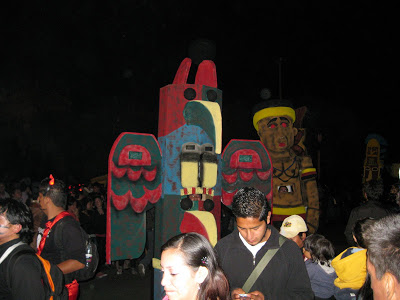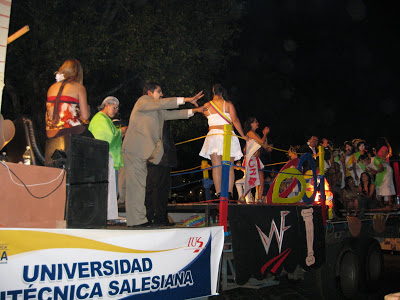The times around the New Year in Ecuador are marked by so many parades, festivals and celebrations. Pase del Niño, El Año Viejo and Carnaval all seem to come one after another. There’s one more party that ought to be added to that list, one which many visitors to Cuenca will miss if they aren’t in the right place at the right time.
Fortunately for me, I happened to stumble upon it the first year I was here, having no idea what I had found. One January evening, intending only to meet my friends after dinner, I walked down the Bajada del Padron from my old apartment downtown, towards the river Tomebamba. And there, across the wide expanse of Avenida Solano, were countless teenagers all dressed up like the denizens of hell. Hmm. Demons and ghosts, horns and pitchforks, and everyone dressed in black. Among them, floats rolled along, as big and ornate as those you would see for the Pase del Niño. But instead of the homages to the baby Jesus that are famously paraded at Christmas, these were garish and infernal, like a Macy’s Halloween Day parade.
Only later did I find out that I had witnessed the Day of the Innocents. At the time, I was happy enough knowing that I wasn’t the only one confused by my surroundings. I somehow ran into my friends, who were as astonished as I was by the improbable spectacle, and together we wandered up and down the boulevard to see more. Avenida Solano, ordinarily a main thoroughfare of Cuenca’s car traffic, had transformed into a mix of parade, concert and county fair. While the avenue itself was given over to the parading masses of young people and their accompanying devilish floats, the tree-lined boulevard along the center was jammed with spectators and vendors of cotton candy, fried pastries and marinated skewers of meat. The crowd itself was dressed up as well, every other person wearing what would be Halloween costumes in the US. Also, oddly enough, many teenage boys had gotten a hold of girl’s uniforms from any of the countless high schools in Cuenca, and were walking the avenue shamelessly in their stuffed bras.
Along the edges of several intersections, big stages had been set up, and from them, live music at high volume lended itself to the milieu. Add to all this a throng of spectators so thick that navigating through it was impossible without pushing your way through the tangle of glow-in-the-dark horns, latex monster masks and schoolgirl outfits, and you’ve got yourself a party, albeit a weird one.
That particular year, we were satisfied after a lap around the main concentration of people, floats, and costumes, and went on our way. Later on, I got myself informed on exactly what it was I had witnessed. The Day of the Innocents, commemorating the day in which King Herod ordered all children under the age of two to be killed, has manifested in Cuenca into a real non sequitur of a celebration. Originally a sort of April Fool’s celebration in which people played pranks on one another, it has lost much of its emphasis in many parts of Ecuador. In Cuenca, however, it has become a big parade. The trick-playing is still a part of it, with men dressed in drag, spontaneously kissing other men who aren’t in costume. I haven’t gotten a good explanation for the costumes, but one’s imagination can fill in the blanks. My own has led me to believe that King Herod’s wicked act is manifested in the Halloween-style portrayal of those many innocent souls all lost in some sort of limbo.
Last year, rain got the party off to a late start, and after some time waiting under an umbrella, I gave up looking for a repeat of my previous experience and went home. 2010, however, found our little family ready for the big event. Avenida Solano being on my current walk home, I was able to see that the party was already getting started on my way back from work. At the house, Nancy had put together a patchwork of costumes for each of us, including my sister-in-law Lourdes, who works in our neighborhood, and our little niece Giomara.
Here they were, in their respective outfits. Breaking a bit from the tradition, perhaps, our daughter was a lion, Lourdes a giraffe, and Giomara a drop of water. My wife, for her part, was someone in a curly, black wig. Were she to have turned around for this picture, you would have seen the true brunt of her costume, namely the sign taped to her back: respeto al peatón. Which is to say, respect the pedestrian. Fortunately, tonight was a night for walking, as this normally busy street was closed to all but foot traffic and floats. My own costume fit more tidily into the traditional spectrum, which I suppose I’ll include further along.
As their route home on the bus was currently blocked by the big party in the street, Luli and Giomi accompanied us until the other side of the celebration. Along the way we got our first taste of this year’s parade.
This year’s parade had a decidedly multicultural theme, with the demonic of two years ago giving way to pagan traditions from around the world.
And of course, no Ecuadorian parade would be complete without some sort of political statement:
What does it mean? As usual, I have no idea. Parading around the ring for la lucha libre were scantily clad women representing various newspapers around Ecuador, if that gives any insight. Beyond that, your interpretation is as good as mine.
Día de los inocentes, taking place just days after el año viejo, is just as full of larger-than-life displays as New Year’s Eve (which, incidently, is highlighted in the next entry down. Or, for your convenience, here). Where does all the energy come from? Within a week you can see two massive outbursts of the creative urge, one spread around the city and the other concentrated in a parade along just a few city blocks. Part of the explanation comes from the prizes awarded. For both this and el año viejo, there is a cash prize of a quantity unknown to me. But for the sheer size, and number of entries, one must assume a return on the investment is possible.
Amazing what a little endowment for the arts can do. Maybe only one or two win, but dozens play, all for the public’s entertainment. And, much like my experience of two years before, there was plenty of public around. For several blocks, walking was a true exercise in patience and tenacity. It seemed as though half the city had crammed into this boulevard, and however wide it is, it was still full and overflowing. It makes one wonder what happens to all the little plastic cups and paper plates after the party’s over. And for that matter, the floats themselves. For the New Year’s effigies, at least, the tradition itself solves much of the clean-up issue. Burn it! But in the case of the Innocents, there’s no fiery sublimation in store for the pagan figures, and once they’ve been paraded around, one must assume their day in the sun will have come and gone.
But don’t despair. A closer look at many of these floats reveals that they are made of mere cardboard! For all their showy colors, they will, by virtue of their humble biodegradability, go back from whence they came.
And so it was for us, in a metaphorical stretch. Many a picture had been taken, many a presentation seen. We witnessed everything from ancient cultures at the height of their respective glories, to Michael Jackson (not pictured) dancing with Carlos Crespi. We even ate some street food. After all of that, I was ready to walk home, take off the itchy false beard, and call it a night. So far, the new year is off to a good start!

Brian Horstman is a teacher of English as well as a traveler, writer, photographer and cyclist. His interest in traveling around Latin America began while he was living in New Mexico, where he began to experience the Latino culture that lives on there. From there he spent time in Oaxaca, Mexico and has since been living in Cuenca, Ecuador and will be living in Chile starting in 2011. Cal’s Travels chronicles some of his more memorable experiences from Mexico and Ecuador, as well as some side trips to other parts.















